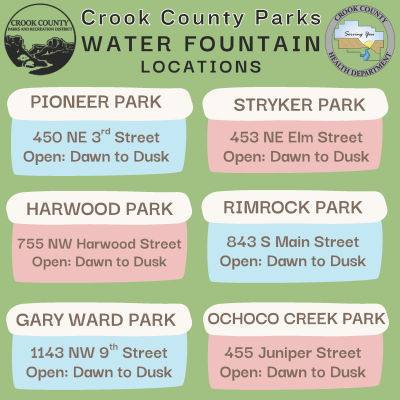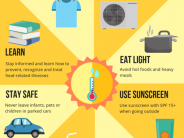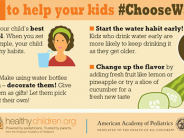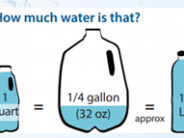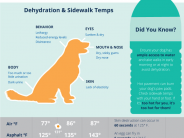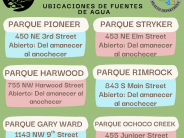Seasonal Hazards: Extreme Heat
Current Hazards
During periods of extreme heat some members of the community may need help finding a cool place to be. See our suggestions below of places in Crook County to beat the heat. Always call your primary care provider if you are experiencing heat-related illness symptoms. Crook County Health Department staff is here to help you find resources during upcoming heat waves and other seasonal hazards. Please call 541-447-5165 for more information.
Where to stay cool in Crook County:
- Crook County Library (M-F 9am-7pm & Sat 10am-4pm)
- Kiwanis Splash Pad at Stryker Park
- Prineville Community Pool
- Haystack Reservoir
- Ochoco Lake
Seasonal Overview:
We are entering the hottest months of the year in Central Oregon. Summer heat waves and high heat can impact all residents in Crook County. Socioeconomic factors (income, age, access to transportation) can increase the risk of negative health impacts caused by heat. Those who experience the greatest effects of high heat are:
- outdoor workers
- athletes
- low-income households
- older adults/children
- individuals with health conditions
Heat-related Illnesses: Signs and Symptoms
Temperatures above 90 degrees pose an increased risk for health problems. High temperatures can cause the body to become dehydrated more quickly than it can cool itself down. This can lead to severe sunburns, heat exhaustion, and even heat stroke. See the signs below of heat related illnesses and learn how to treat the symptoms listed below.
Heat Exhaustion |
Heat Stroke |
|
|
-
How-to-Hydrate 101
In order to stay healthy during periods of extreme heat, it is important to be hydrating before any exposure to the heat. By the time you feel thirsty... you are already behind. While exposed to heat, the goal should be to drink 3/4 to 1 quart of water per hour in intervals. This is about 2 standard water bottles every hour.
-
Keeping Kids Healthy
Young children are one of the most vulnerable groups that are affected by extreme heat. Oftentimes, with kids on summer break, there is an increase amount of time spent outside and an increased exposure to high temperatures. In addition, the change in routine from summer break can cause parents to be more likely to forget their child in hot cars.
Here are some suggestions below on how to prevent heat-related accidents for your children:
- Find ways to make drinking water "fun" (add fresh fruit, decorate water bottles, and drink water with them!)
- Make sure that children always have proper sun protection when outdoors
- Sunscreen
- Hats (preferably covering the neck area)
- Sunglasses
- UV protective tops or loose-fitting clothing
- NEVER leave children in parked cars (temperatures can rise 20 degrees in the first minute, even with windows cracked open)
- Keep your phone, bag, and any other important items in the backseat to help prevent accidentally forgetting a child in the car
Pet Health:
Just like humans, high heat can cause severe injury to our animals. Make sure pets have sufficient access to water and shade, are never left alone in hot cars, and limit outdoor exercise on hot days. Temperatures above 80 degrees, indoors and outdoors, can increase the risk of heat stroke in animals.
Additional Resources
- Low-income energy assistance program
- Ways to Keep Your Energy Bill Down in a Heat Wave
- How Extreme Weather Threatens People with Disabilities
- Dial-a-Ride Transportation Services in Central Oregon

